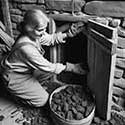Preparations for a coal delivery, early 20th century

Preparing for a coal delivery on Britain's numerous Victorian housing estates was no simple matter because the coal-holes were inside the houses. The coalman, black with coal dust, and carrying his sacks, also black with coal dust, had to come through the narrow passage that was effectively the hall to shoot the coal into the coal-hole. This page describes and explains what was involved for the housewife from firsthand experience.
____
Extracted from the memoirs of the webmaster's mother (1906-2002) and edited by the webmaster with further research and firsthand contributions from others
When I was a child on a typical housing estate in the early 1900s, coal fires were our only means of heating rooms, heating hot water and cooking. So coal was an essential item and was delivered to the house on a regular basis.
Ordering and paying for coal
My mother generally ordered 'Derby Brights', as there was a big difference in the various types of coal. Poor quality coal would usually look all right, but it would not burn properly on the fire, being more like slate, and the grate in the morning would be a mass of grey ash.
It was the job of the coal agent, to take an order and to receive the payment. He visited houses regulary to take orders. Coalmen themselves never dealt with money when they delivered.
The coal hole or coalhole where the coalman put the coal
In order to understand what had to be done before the actual coal delivery, it is important to understand that there was nowhere to store the coal outside on Victorian and Edwardian housing estates. All the houses had what was called a 'coal hole' or coalhole which was a cupboard which ran under the stairs and looked like a wooden wall from the outside. It was made out of tongued and grooved planks, so no coal dust seeped out into the room. It was not really much of a hole - more like a slightly sunken small room. The entrance door was in the scullery or the kitchen, depending on the layout of the house.
To get to the coal hole, the coalman who delivered the coal had to come through the passage also known as the hall or hallway, and then the kitchen, our living room, into the scullery. When he shot the coal from its bag into the coal hole, the noise was terrific as the coal hit the wooden wall.
In contrast, large houses such as those in Pymmes Villas, had their coal cellars underground, which the coalmen could access from outside. The openings were in the front gardens and normally covered with a metal lid. I suppose one gets what one pays for in this life. Those houses were bought outright whereas my parents' house, along with all the others on the estate, were rented.
Preparing for the coal delivery
We could never be sure what day or time the coalman would arrive. This annoyed my mother, particularly if she had done a lot of cleaning beforehand - the coal was dirty and the coal hole was inside the house.
When the coalman knocked at the door to announce a delivery, my mother's first tasks were to tie back the lantern which hung from the ceiling and the curtain which hung at the bottom of the stairs, so that he wouldn't hit them with his sacks. Hitting them could be dangerous as well as dirty! - see the contribution in the box below.
Then my mother also had to push the table and chairs into the living room, to give the coalman a clear way through and then line the floor with newspaper to protect from the trail of coal particles left by his boots. It was a annoying, dirty and potentially dangerous business and everything in the house stopped for it.
How a coalman in the house could cause dangerous damage!
contributed by Richard Cole, from a childhood recollection
I particularly remember one occasion when the coalman came. As he carried a bag of coal through the hall, he knocked the gas lamp that was hanging down. The pipe broke off at ceiling level, and gas was pouring into the room. A piece of soap was quickly found, and pushed into the hole to plug the leak, which I considered to be very clever.
| sources | webmaster | contact |
Text and images are copyright
If you can add anything to this page or provide a photo, please contact me.



